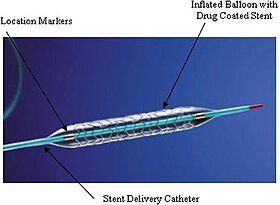| Drug-eluting stent | |
|---|---|
 An example of a drug-eluting stent. This is the TAXUS Express2 Paclitaxel-Eluting Coronary Stent System, which releases paclitaxel. The system consists of a catheter delivery element, an inflation system, and the drug-eluting stent itself. They are marketed as one integrated system. | |
| ICD-9-CM | 00.55 |
| MeSH | D054855 |
A drug-eluting stent (DES) is a tube made of a mesh-like material used to treat narrowed arteries in medical procedures both mechanically (by providing a supporting scaffold inside the artery) and pharmacologically (by slowly releasing a pharmaceutical compound). A DES is inserted into a narrowed artery using a delivery catheter usually inserted through a larger artery in the groin or wrist. The stent assembly has the DES mechanism attached towards the front of the stent, and usually is composed of the collapsed stent over a collapsed polymeric balloon mechanism, the balloon mechanism is inflated and used to expand the meshed stent once in position. The stent expands, embedding into the occluded artery wall, keeping the artery open, thereby improving blood flow. The mesh design allows for stent expansion and also for new healthy vessel endothelial cells to grow through and around it, securing it in place.[1][2][3]
A DES is different from other types of stents in that it has a coating that delivers medication directly into the blood vessel wall. The stent slowly releases a drug to prevent the growth of scar tissue and new obstructive plaque material which caused the original blood vessel stenosis, this clogging of a stent is termed restenosis. A DES is fully integrated with a catheter delivery system and is viewed as one integrated medical device.[4][5][6]
DESs are commonly used in the treatment of narrowed arteries in the heart (coronary artery disease), but also elsewhere in the body, especially the legs (peripheral artery disease).[7] Over the last three decades, coronary stenting has matured into a primary minimally invasive treatment tool in managing CAD.[8] Coronary artery stenting is inherently tied to percutaneous coronary intervention (PCI) procedures. PCI is a minimally invasive procedure performed via a catheter (not by open-chest surgery), it is the medical procedure used to place a DES in narrowed coronary arteries. PCI procedures are performed by an interventional cardiologist using fluoroscopic imaging techniques to see the location of the required DES placement. PCI uses larger peripheral arteries in the arms or the legs to thread a catheter/DES device through the arterial system and place the DES in the narrowed coronary artery or arteries.[7] Multiple stents are often used depending on the degree of blockage and the number of diseased coronary arteries that are being treated.[9][10]

- ^ "Stent: MedlinePlus Medical Encyclopedia". Archived from the original on 5 July 2016. Retrieved 10 March 2024.
- ^ "Drug-Eluting Stents Information". Archived from the original on 10 March 2024. Retrieved 10 March 2024.
- ^ Senst B, Goyal A, Basit H, Borger J (2024). "Drug Eluting Stent Compounds". StatPearls. PMID 30726034. Archived from the original on 11 March 2024. Retrieved 10 March 2024.
- ^ Stone G (2006). "Drug-eluting Stents - Current and Future Perspectives". Interventional Cardiology. 1 (1): 28–29. doi:10.15420/icr.2006.1.1.28. Archived from the original on 20 November 2023. Retrieved 20 November 2023.
- ^ "Onyx Frontier DES - Coronary Stents". Medtronic. Archived from the original on 19 November 2023. Retrieved 23 November 2023.
- ^ "Promus PREMIER™ Drug-Eluting Coronary Stent System". www.bostonscientific.com. Archived from the original on 23 November 2023. Retrieved 23 November 2023.
- ^ a b Velagapudi C, Madassery S (November 2022). "Drug-eluting stents". Semin Intervent Radiol. 39 (4): 400–405. doi:10.1055/s-0042-1758078. PMC 9671677. PMID 36406018.
- ^ Iqbal J, Gunn J, Serruys PW (2013). "Coronary stents: historical development, current status and future directions". British Medical Bulletin. 106: 193–211. doi:10.1093/bmb/ldt009. PMID 23532779. S2CID 14423973.
- ^ Bin QS, Wen LS, Bo X, Jue C, Bo LH, Jin YY, et al. (September 2009). "Clinical outcomes for single stent and multiple stents in contemporary practice". Clin Cardiol. 32 (9): E33–9. doi:10.1002/clc.20516. PMC 6653171. PMID 19645042.
- ^ Tsagalou E, Chieffo A, Iakovou I, Ge L, Sangiorgi GM, Corvaja N, et al. (May 2005). "Multiple overlapping drug-eluting stents to treat diffuse disease of the left anterior descending coronary artery". J Am Coll Cardiol. 45 (10): 1570–3. doi:10.1016/j.jacc.2005.01.049. PMID 15893168.